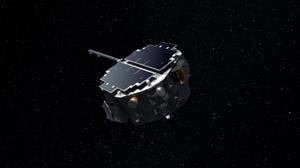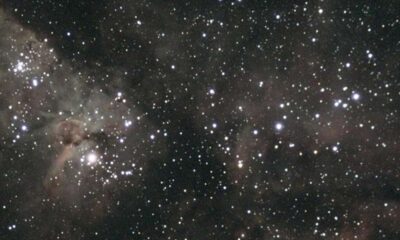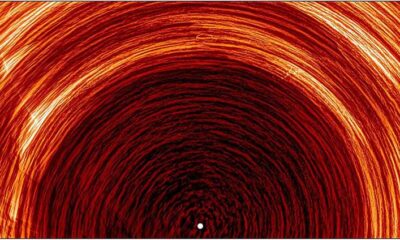Science
Stunning Footage of Fusion Experiment Highlights Scientific Progress

Recent footage released by the British fusion firm Tokamak Energy showcases a remarkable experiment in nuclear fusion, capturing the extreme physics involved in the process. The video, recorded with a high-speed color camera, features a donut-shaped chamber known as a tokamak, enveloped in a vibrant pink cloud of glowing hydrogen plasma. This plasma reaches temperatures exceeding those found in the core of the Sun, all contained within a powerful magnetic field.
The footage reveals not only the plasma but also a striking display of lithium grains being injected into the chamber. Initially appearing as a brilliant red, the lithium transitions to a bright green halo as it descends deeper into the plasma due to ionization. Each plasma pulse lasts approximately a fifth of a second, and the high-speed camera captures the action at an impressive rate of 16,000 frames per second.
Understanding Nuclear Fusion
Nuclear fusion, the process that fuels stars for billions of years, including our Sun, involves merging small hydrogen atoms in a superheated plasma environment. This reaction releases an enormous amount of energy. However, replicating this phenomenon on Earth poses significant challenges, primarily because the gravitational forces that facilitate fusion in stars are absent.
Using a tokamak allows scientists to create a strong magnetic field with superconducting magnets, which traps the extremely hot plasma that no solid material can withstand. The fuel for this process is hydrogen, the most abundant element in the universe, but there are complications. Certain isotopes of hydrogen, such as deuterium, are rare on Earth, while tritium is even scarcer. Scientists often need to “breed” tritium by irradiating lithium, which is also in limited supply.
Despite these hurdles, fusion is considered a safer alternative to nuclear fission, as the radiation produced during fusion has a much shorter half-life compared to that of elements like plutonium or uranium.
Challenges and Future Prospects
Currently, human attempts to initiate fusion require more energy input than the energy produced, making practical applications still a long way off. Nonetheless, the captivating footage serves as a valuable resource for scientists working in the field.
Laura Zhang, a physicist at Tokamak Energy, emphasized the significance of the color camera in experimental settings. “The color camera is especially helpful for experiments like these,” she stated. “It helps us immediately identify whether the gaseous impurities we’re introducing are radiating at the expected place, and whether lithium powders are penetrating to the plasma core.”
As research in nuclear fusion advances, the insights gained from such experiments may pave the way for breakthroughs that could eventually lead to sustainable energy solutions. The stunning visuals not only highlight the scientific progress being made but also spark interest in the potential of fusion energy for the future.
-

 Technology5 months ago
Technology5 months agoDiscover the Top 10 Calorie Counting Apps of 2025
-

 Health2 months ago
Health2 months agoBella Hadid Shares Health Update After Treatment for Lyme Disease
-

 Health3 months ago
Health3 months agoErin Bates Shares Recovery Update Following Sepsis Complications
-

 Technology4 months ago
Technology4 months agoDiscover How to Reverse Image Search Using ChatGPT Effortlessly
-

 Technology1 month ago
Technology1 month agoDiscover 2025’s Top GPUs for Exceptional 4K Gaming Performance
-

 Technology2 months ago
Technology2 months agoElectric Moto Influencer Surronster Arrested in Tijuana
-

 Technology5 months ago
Technology5 months agoMeta Initiates $60B AI Data Center Expansion, Starting in Ohio
-

 Technology5 months ago
Technology5 months agoRecovering a Suspended TikTok Account: A Step-by-Step Guide
-

 Health4 months ago
Health4 months agoTested: Rab Firewall Mountain Jacket Survives Harsh Conditions
-

 Lifestyle5 months ago
Lifestyle5 months agoBelton Family Reunites After Daughter Survives Hill Country Floods
-

 Technology4 months ago
Technology4 months agoHarmonic Launches AI Chatbot App to Transform Mathematical Reasoning
-

 Technology3 months ago
Technology3 months agoUncovering the Top Five Most Challenging Motorcycles to Ride





















